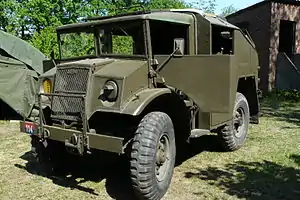CMP FAT
The CMP FAT (Field Artillery Tractor), was a Canadian Military Pattern vehicle manufactured by Ford and Chevrolet. The FAT was an artillery tractor of the British and Commonwealth forces during World War II. Several models were produced by the two manufactures as CGT (Chevrolet Gun Tractor) and FGT (Ford Gun Tractor).

| CMP Quad | |
|---|---|
 Seen at Bridgehead, Bussum (Netherlands) | |
| Type | Artillery tractor |
| Place of origin | Canada |
| Specifications | |
| Mass | 10,880 pounds (empty) 13,200 pounds (gross) |
| Length | 14 feet 1 inch |
| Width | 7 feet 6 inches |
| Height | 8 feet |
| Crew | 1 + 5 passengers |
| Armor | none |
| Engine | Chevrolet, 6-cyl 216 cubic inch petrol 85 bhp (52 kW) |
| Suspension | Wheel, 4 x 4 |
CMP stood for Canadian Military Pattern and was applied to a number of trucks, artillery tractors and utility vehicles built in Canada that combined British design requirements with North American automotive engineering.[1]
As with other FATs, the CMP was usually used to tow either the 25 pounder gun-howitzer or the 17 pounder anti-tank gun. A power winch was located above the rear axle for manoeuvring the gun or unbogging the vehicle.
History
Specification was based on the successful British Morris C8 FAT developed before the war, even incorporating right-hand-drive steering. The first models were produced in 1940/41 and the body went through a number of design changes throughout the war. Being based on the British vehicle, CMPs were used extensively by British and Commonwealth forces replacing lost stocks after the Dunkirk evacuation.
Post-war examples were supplied to Denmark who provided their own bodywork.[2]
Variants
Main vehicles were produced as :
- Chevrolet 8440/CGT Tractor, 4x4, Field Artillery
- Ford C291Q FGT Tractor, 4x4, Field Artillery
These could be fitted with different bodies:
- 7A1 beetle-back body with two doors and solid roof
- 7A2 beetle back body with two doors and open (canvas covered) centre roof section
- 7B1 beetle-back body with four doors and open (canvas covered) centre roof section
- 7B2 beetle-back body with four doors and open (canvas covered) centre roof section. Tyre carrier on rear sloped roof.
FATs made locally in Australia had different bodies.
FATs supplied to India were shipped as bare chassis. Bodies were locally made upon delivery. Some vehicles had armoured bodies locally made, while the majority were of wooden construction.
See also
- Canadian Military Pattern trucks
- Morris C8, a similar British vehicle by Morris. This had very similar bodywork to the early CMP FAT, but can be identified by a five-sided windscreen glass, with the upper corner cut away, compared to the four-sided CMP screen.
- List of military equipment of the Canadian Army during the Second World War
References
- Bart Vanderveen (1989) 'Historic Military Vehicles Directory'. P. 40
- Bart Vanderveen (1989) 'Historic Military Vehicles Directory'. P. 52
External links
| Wikimedia Commons has media related to Chevrolet CGT Field Artillery Tractor. |
